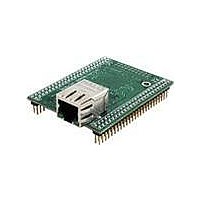MOD5234-100IR NetBurner Inc, MOD5234-100IR Datasheet - Page 475

MOD5234-100IR
Manufacturer Part Number
MOD5234-100IR
Description
MOD5234 10/100 ETHERNET MODULE
Manufacturer
NetBurner Inc
Type
Controllers & Processorsr
Datasheets
1.MOD5272-100IR.pdf
(3 pages)
2.MOD5234-100IR.pdf
(4 pages)
3.MOD5234-100IR.pdf
(754 pages)
Specifications of MOD5234-100IR
Interface
I²C, SPI, UART
Voltage - Supply
2.5V
Mounting Type
Surface Mount
Package / Case
Module
Product
Modules
Lead Free Status / RoHS Status
Lead free / RoHS Compliant
Data Format
-
Baud Rates
-
Lead Free Status / Rohs Status
Lead free / RoHS Compliant
Other names
Q4483564
- Current page: 475 of 754
- Download datasheet (13Mb)
Freescale Semiconductor
31–24,
23–16,
31–28
27–24
19–16
15–8,
15–0
28–0
Bits
7–0
23
22
21
20
ID [28:18]
LENGTH
ID [17:0)
STAMP
CODE
Name
DATA
TIME
SRR
RTR
IDE
—
—
Table 21-12. Message Buffer Field Descriptions
Reserved, should be cleared.
Message buffer code. Can be accessed (read or write) by the CPU and by the FlexCAN
module itself, as part of the message buffer matching and arbitration process. The
encoding is shown in
Overview” for additional information.
Reserved, should be cleared.
Substitute remote request. Fixed recessive bit, used only in extended format. It must be
set by the user for transmission (Tx Buffers) and will be stored with the value received on
the CAN bus for Rx receiving buffers. It can be received as either recessive or dominant.
If FlexCAN receives this bit as dominant, then it is interpreted as arbitration loss.
0 Dominant is not a valid value for transmission in Extended Format frames
1 Recessive value is compulsory for transmission in Extended Format frames
ID extended bit. Identifies whether the frame format is standard or extended.
0 Standard frame format
1 Extended frame format
Remote transmission request. Used for requesting transmissions of a data frame. If
FlexCAN transmits this bit as 1 (recessive) and receives it as 0 (dominant), it is interpreted
as arbitration loss. If this bit is transmitted as 0 (dominant), then if it is received as 1
(recessive), the FlexCAN module treats it as bit error. If the value received matches the
value transmitted, it is considered as a successful bit transmission.
0 Indicates the current MB has a data frame to be transmitted
1 Indicates the current MB has a remote frame to be transmitted
Length of data in bytes. Indicates the length (in bytes) of the Rx or Tx data; data is located
in offset 0x8 through 0xF of the MB space (see
written by the FlexCAN module, copied from the DLC (data length code) field of the
received frame. DLC is defined by the CAN Specification and refers to the data length of
the actual frame before it is copied into the message buffer. In transmission, this field is
written by the CPU and is used as the DLC field value of the frame to be transmitted.
When RTR is set, the frame to be transmitted is a remote frame and will be transmitted
without the DATA field, regardless of the LENGTH field.
Free-running counter time stamp. Stores the value of the free-running timer which is
captured when the beginning of the identifier (ID) field appears on the CAN bus.
Standard frame identifier: In standard frame format, only the 11 most significant bits (28 to
18) are used for frame identification in both receive and transmit cases. The 18 least
significant bits are ignored.
Extended frame identifier: In extended frame format, all bits (both the 11 bits of the
standard frame identifier and the 18 bits of the extended frame identifier) are used for
frame identification in both receive and transmit cases.
Data field. Up to eight bytes can be used for a data frame. For Rx frames, the data is stored
as it is received from the CAN bus. For Tx frames, the CPU provides the data to be
transmitted within the frame.
MCF5235 Reference Manual, Rev. 2
Table 21-13
and
Description
Table
21-14. See
Figure
21-11). In reception, this field is
Section 21.4, “Functional
Memory Map/Register Definition
21-21
Related parts for MOD5234-100IR
Image
Part Number
Description
Manufacturer
Datasheet
Request
R

Part Number:
Description:
MCU, MPU & DSP Development Tools MOD5234 MODULE
Manufacturer:
NetBurner Inc
Datasheet:

Part Number:
Description:
MCU, MPU & DSP Development Tools MOD5234 Core Module Development Kit
Manufacturer:
NetBurner Inc
Datasheet:

Part Number:
Description:
BOARD SERIAL-ETHERNET 512K FLASH
Manufacturer:
NetBurner Inc
Datasheet:

Part Number:
Description:
PROCESSOR MODULE FLASH MOD5272
Manufacturer:
NetBurner Inc
Datasheet:

Part Number:
Description:
PROCESSOR MODULE 512KB FLASH
Manufacturer:
NetBurner Inc
Datasheet:

Part Number:
Description:
DUAL PORT SERIAL-ETHERNET
Manufacturer:
NetBurner Inc
Datasheet:

Part Number:
Description:
PROCESSOR MODULE FLASH
Manufacturer:
NetBurner Inc
Datasheet:

Part Number:
Description:
PROCESSOR MODULE 512KB FLASH
Manufacturer:
NetBurner Inc
Datasheet:

Part Number:
Description:
KIT DEVELOP NETWORK FOR MOD5282
Manufacturer:
NetBurner Inc
Datasheet:

Part Number:
Description:
KIT DEVELOP NETWORK FOR MOD5272
Manufacturer:
NetBurner Inc
Datasheet:

Part Number:
Description:
DUAL PORT SERIAL-ETHERNET
Manufacturer:
NetBurner Inc
Datasheet:

Part Number:
Description:
Ethernet Modules & Development Tools 32 Bit 66MHz 40 Pin DIP Industrial Temp
Manufacturer:
NetBurner Inc
Datasheet:

Part Number:
Description:
Ethernet ICs 32bit 147MHz CAN-to- Ethnt Device IndTemp
Manufacturer:
NetBurner Inc
Datasheet:










